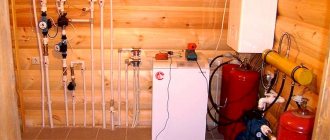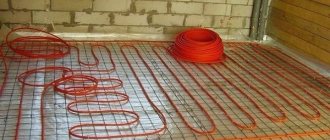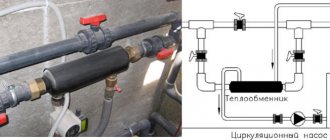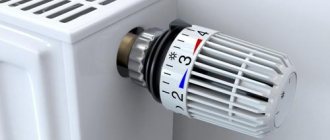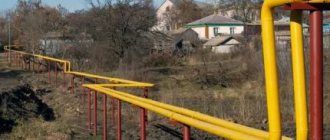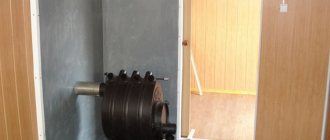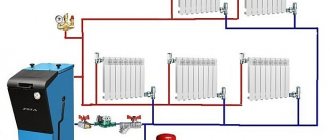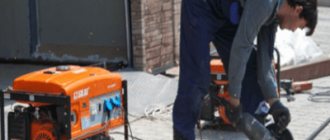When the construction of private buildings is at the design stage, selecting the optimal heat supply method is much easier. The area of construction, number of floors, and planned insulation are taken into account. No less significant are other characteristics and factors that are beneficial after the calculation of heat loss is completed. Many people today want to make heating without radiators. And today there are many alternatives. Let's take a look at them.
If you decide to avoid installing radiators inside the building, there are several alternative heating methods:
- air systems;
- water heating,
- use of convectors;
- heating using a pipeline device.
Air systems
The above type of heating may appear:
- single heater,
- the whole complex.
The complex provides the availability of heat sources and air ducts.
This is due to the maintenance and prompt provision of an increase in temperature, which can be ensured by this technique.
The presented type of heat supply is widespread:
- household sector (residential apartments, dachas, mansions),
- industry (warehouses, factory buildings).
The direct heat distributor is a pump with an internal hydraulic unit or a gas generator.
The device produces a specific amount of warm air required to heat the building, as a result of which it is distributed through a network of air ducts. It is supplied to the territory through air distribution devices. Thus, thermal saturation of the space occurs.
The following positive characteristics of the method can be identified:
- Convenient indoor temperature regulator.
- Lack of necessary installation near the windows of heating devices (as a result, heating will be without batteries) . The room looks harmonious from an aesthetic point of view. In addition, there is wide scope for implementing all kinds of designer solutions.
- Such a system supplies heat to the rooms in winter; In the summer it works like an air conditioner - for cooling.
But this principle of heat supply has a number of flaws:
- If the source of heat is a gas generator, then a significant minus is the cost of the energy resource . This fact guarantees an increase in operating costs of the system.
- The need to heat a home will require a significant amount of air. This entails the need to install large-sized air ducts that are sewn into the space under the ceiling. The situation turns out to be that the ceiling level has to be lowered to a certain height.
- Classic heat supply is considered the most optimal, when it is cool at the top and warm at the bottom. The air heating system is designed in the opposite way - the space above is perfectly warmed up, while the space below is in cold conditions. The way out of the situation is to organize a supply of warm air from the floor. Proper implementation of the system’s activities achieves the required climatic conditions.
- Reduced inertia leading to rapid cooling of the space. The reason is the instantaneous shutdown of devices.
It is rational to use air heating inside residential premises, where the heat source is a pump. It is irrational to use it as the main heat transferr, since it provides heating as a backup source.
Heating via underfloor heating
It is worth noting that the heating scheme is very relevant today and is quite in demand. Although it became widely used relatively recently. Often you can do without radiators. Before installation, you need to decide whether it is justified. Since heating boilers are used quite often, it is rational to use the heating method by installing a heated floor.
This diagram is a pipe layout hidden under the floor covering. The room is heated by the heat carrier spreading through the pipes. They can be installed in several ways that affect the efficiency of the system under certain operating conditions.
Installation of a heated floor involves pipeline contours:
- snake configuration (zigzag arrangement);
- snail configuration (this installation involves a spiral arrangement of pipes).
Professionals in this matter consider the latest installation scheme to provide optimal, high-quality floor heating. When laying pipes, it is important to maintain a gap between them. It is usually calculated from power calculation considerations. It is recommended to reduce the gap as you approach the windows, and increase it when you reach the center.
Warming up buildings with a “warm floor” scheme requires a reasonable temperature distribution. The floor is heated identically over the entire surface area. The maximum value is 26°C, thereby providing a comfortable feeling to the legs. Under the ceiling, the temperature drops significantly, reaching approximately 22°C at human height.
Communications are located under the finished floor covering, and therefore designers do not have to rack their brains over interior design.
Heated floors are a winning option when it comes to saving energy consumption, as a result of which you can save your budget from financial waste. In most cases, if the heat loss at home is not great, you can do without installing radiators.
Do-it-yourself installation recommendations
To lay the main natural circulation lines, it is better to use polypropylene or steel pipes. The reason is the large diameter, polyethylene Ø40 mm and more is too expensive. We make radiator hoses from any convenient material.
Advice. When assembling a gravity heating network made of metal-plastic, do not install compression fittings - they greatly reduce the internal passage.
How to make the layout correctly and withstand all the slopes:
- Start with markings. Mark the locations for installing batteries, connection points for connections, and routes for highways.
- Mark the routes on the walls with a pencil, starting from the distant batteries. Adjust the amount of inclination using a long building level.
- Move from the outer radiators to the boiler room. When you draw all the routes, you will understand at what level to install the heat generator. The inlet pipe of the unit (for cooled coolant) must be located at the same level or below the return line.
- If the firebox floor level is too high, try moving all the heaters up. Horizontal pipelines will rise next. As a last resort, make a recess under the boiler.
Laying a return line in a furnace room with a parallel connection to two boilers.
After marking, punch holes in the partitions and cut grooves for a hidden gasket. Then check the routes again, make adjustments and proceed with installation. Follow the same order: first secure the batteries, then lay the pipes towards the combustion chamber. Install an expansion tank with a drain pipe.
The gravity pipeline network is filled without problems; Mayevsky’s taps do not need to be touched. Just slowly pump water through the fill valve at the lowest point, all the air will go into the open tank. If any radiator remains cold after warming up, use a manual air vent.
Electric heating options
Electric convectors are considered the most popular device for this method of heating rooms. The main advantage is fast heating.
Besides:
- they have an easy installation system,
- they are comfortable to use.
The principle of operation is quite simple: the heat exchanger heats water and supplies it to the system using a pump.
A convector, at its core, is nothing more than a simple classic heater. It is worth paying attention - it provides heat only to the space within which it is located. Therefore, it is important to calculate the power of the device for each individual room.
Other characteristics of the device, in addition to power, are no less important. For example, the size of the case. It affects the speed of air flow entering the room. A height of about 50 cm is considered optimal.
Also, such convectors are completely safe, since their body does not heat up above the norm of 45-65 ° C. They can also be supplemented with other useful devices - such as an ionizer or antifreeze.
How to make a heating system with natural circulation
In the event of a power outage, the circulation pump stops, and the flow of water through the pipes of the heating network of a private house stops. The problem can be solved in 3 ways: installing an uninterruptible power supply unit, starting an electric generator, or organizing gravity flow. This means a heating system with natural circulation - convection movement of the coolant without the help of a pump. We'll tell you how to develop and make such a circuit with your own hands.
Heating with gas convectors
The devices mentioned above are powered by gas supply. Their positive features:
- noiselessness,
- profitability.
Gas convectors are an ideal choice for installation in an apartment or country house. The device serves not only as the main one, but also as a backup temperature controller (the temperature can rise to 38 °C).
The system is powered by natural as well as liquefied hydrocarbon gas. The fuel change occurs due to the settings of the gas valve.
The device is usually mounted on a window sill. The kit includes pipe routing and temperature sensors. This device significantly minimizes heat loss, which is an important advantage.
A flaw in the system is manifested in the construction of holes in the walls to provide chimney channels.
Heating with pipes
When arranging heating systems for country cottages, pipes are rarely used. It is required that their length be impressive, and their diameter reach 60-100 mm (sometimes even more). This will provide the necessary heat transfer flow. Now this system looks very absurd, but there is heating without radiators.
If you decide to lay a pipeline instead of radiators, you must:
- heating boiler;
- pipes;
- expansion tank;
- jumper.
The pipes are installed horizontally. The jumper serves as a connecting element. Its diameter should be less than the diameter of the pipe.
Method for creating a battery from pipes
We offer detailed instructions for making a battery from pipes with your own hands, which will help you avoid mistakes in operation.
So, first of all, a long and thick pipe is cut into three equal sections. To make it smooth, you need to apply markings to the pipe in advance.
On each segment, with an indentation of 5 cm from the ends, two holes with a cross section of 2.5 cm are cut, located at 180° to each other. In this case, you need to use a welding machine. At the end of the work, scale should be cleaned from the pipes.
6 round plugs with a diameter of 10 cm are cut out of a sheet of steel, and the end parts of the pipes are closed with them using welding.
A thinner tube is cut into two parts with a grinder and welded to the previously made holes of 2.5 mm in diameter on the large pipe.
Next, pieces of reinforcement 10 cm long are welded to these thin tubes to make the entire structure of the homemade heating radiator made from pipes more durable.
At the last stage, the bends are welded to the input and return circuits. At this point, the assembly work can be considered complete.
To check the reliability and tightness of a home-made heating radiator made from pipes, you need to shut off one outlet and then pour water into the structure. This way, you can check whether the radiator is leaking, and if so, where exactly. If imperfections are found in the structure, you need to drain the water and re-weld all the seams where leaks were found.
It is worth noting that installing heating pipes without radiators will cost significantly less than purchasing industrial batteries.


